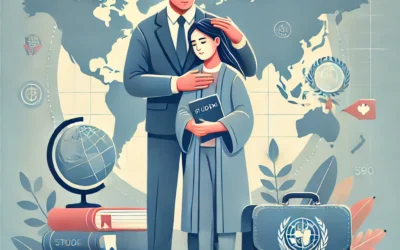Student Visa Subclass 500 Updates, Australia remains among the world’s leading destinations for foreign students seeking access to quality education as well as post-study work. New changes, however, were introduced to Student Visa Subclass 500 in July 2025, which revolutionized Australia’s migration program significantly. Reforms are part of the overall government program aimed at making visa conditions tougher, increasing migration integrity, and ensuring Australia’s international education sector is sustainable.
Table of Contents
1. Draconian Fee Increase
The 25% increase in the student visa Subclass 500 application fee is the most important change introduced on July 1, 2025. The lower limit of visa application charges for a lead applicant increased from AUD 1,600 to AUD 2,000, making it the English-speaking world’s student visa subclass 500 with the highest charges. The increase was made to raise more money and discourage impostor students.
Secondary applicants also pay more:
- A spouse or partner applicant now carries a tag of AUD 1,225
- A dependent child will cost AUD 400
They are extremely costly and place excessive financial burdens, particularly to joint application families.
2. Student Visa Subclass 500 updates – Major Fee Increase
| Applicant Type | Previous Fee | New Fee |
| Primary applicant | $1,600 | $2,000 |
| Secondary applicant (18+) | $1,190 | $1,225 |
| Secondary applicant (<18) | $390 | $400 |
3. Stricter Confirmation of Enrolment (CoE) Conditions
Australian visa subclass 500, From 1 June 2025, applicants must have a current Confirmation of Enrolment (CoE) in their possession at time of application. Conditional offers or letters of offer not linked to enrollment will no longer be accepted. This will reduce the level of non-genuine applications and improve system integrity.
This change necessitates that the student make a decision regarding their college and course choices at the very start of the process of applying. Delay or procrastination can now risk missing the visa granting window.
4. Crackdown on Ghost Colleges
To combat cheating education providers, the Australian government has increased surveillance on schools. Over the last year alone, over 150 “ghost colleges”. colleges with minimal or no real academic business — have been shut down. They are part of a wide campaign to eliminate exploitation in the international education sector and safeguard the image of Australia’s education products.
The service providers are now in the limelight, and students are urged to pick service providers with a good compliance track record and actual infrastructure for academics.

5. Increased English and Financial Requirements
Immigration applicants are now required to have higher levels of English language proficiency for australian visa subclass 500. This is to enable students to prepare well academically for study as well as overall communications in Australia.
Besides this, the finance provisions under capability have also been made more stringent. The students must demonstrate that they can sustain themselves on tuition fees, living costs, and travel fees before entering Australia. The raised levels of finance are intended to ensure students will not have problems once they arrive in Australia and to make sure they will be capable of sustaining themselves throughout the period of their study.
6. Migration Strategy and Visa Limits
The 2025 reforms align with Australia’s overall ten-year Migration Strategy, including an international student visa subclass 500 cap issued in a particular year. That existing cap is 270,000 student visas per year, well below the historical intake of over 400,000.
This cap attempts to strike a balance between the economic benefits of international education and housing shortages, infrastructure overload, and the competition for domestic employment. It is also a policy shift — from growth without restraint to quality and sustainability.
7. Political and Economic Motivations
Part of the motivation behind the increase in the fee and other changes are political and economic pressures. Given an upcoming federal election, the government is between being able to demonstrate effective control of the borders and prudent management of migration on the one side, and having a capacity to raise additional visa revenue, which will contribute more than AUD 750 million to the federal budget over a four-year term, on the other side.
The opposition party has also intimated even higher raised visa fees and stricter quotas, and it is likely that migration reform will form a core political issue in the near future.
8. Effect on Students and Education Providers
For international students immigration make some updates in Australian visa subclass 500, the reforms mean increased entry fees, more complex application processes, and more preparation and planning demands. Students from low- and middle-income nations may not be able to afford the visa process so easily, and therefore reduced student numbers diversity in Australia.
For education providers, regional universities and vocational colleges specifically, there is concern that the reforms will lead to fewer students and funding pressures. Some providers are already seeing a reduction in enquiries from key source countries.
Others think the reforms will improve student quality, reduce drop-out rates and boost graduate rates, ultimately benefiting institutions and the economy.

9. Recommendations for Future Students
Prospective applicants need to do the following to switch to the new requirements:
- Plan ahead: Apply for the enrolment and visa well in advance of your preferred intake.
- Get a detailed CoE: Only lodge when you have a confirmed Enrolment.
- Prep your finances: Ensure that you meet current financial documentation standards.
- Check your provider: Choose well-established, compliant providers.
- Pass English criteria: Plan to take IELTS, TOEFL, or other accepted tests.
Conclusion
Australia’s 2025 re-design of the Subclass 500 Student Visa is an articulation of a strong move towards migration integrity, upgraded standards, and transparency of costs. Although the changes present new complexities, they also affirm Australia’s commitment to world-class education. Properly planned international students who meet all requirements and select genuine providers will remain a positive and diverse context for study and future professional development.









0 Comments